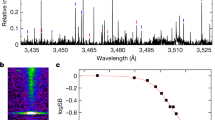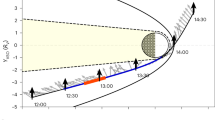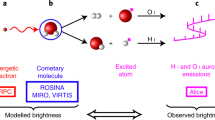Abstract
ON 10 July 1992, the Giotto spacecraft flew within about 200 km of the nucleus of comet Grigg—Skjellerup; this is only the third comet at which in situ measurements have been made, and the encounter constituted the closest approach so far of a spacecraft to a cometary nucleus. Here we report the detection by the EPONA instrument on Giotto of charged, energetic particles deep within the inner coma of Grigg—Skjellerup. In contrast to previous spacecraft encounters with comets Giacobini—Zinner (in 1985) and Halley (in 1986), well defined, periodic intensity variations recorded in the particle fluxes suggest that the ions close to the nucleus were strongly coupled to the ambient magnetic field. The present data indicate that Giotto flew on the nightside of the nucleus.
This is a preview of subscription content, access via your institution
Access options
Subscribe to this journal
Receive 51 print issues and online access
$199.00 per year
only $3.90 per issue
Buy this article
- Purchase on Springer Link
- Instant access to full article PDF
Prices may be subject to local taxes which are calculated during checkout
Similar content being viewed by others
Author information
Authors and Affiliations
Rights and permissions
About this article
Cite this article
McKenna-Lawlor, S., Daly, P., Kirsch, E. et al. Energetic ions at comet Grigg—Skjellerup measured from the Giotto spacecraft. Nature 363, 326–329 (1993). https://doi.org/10.1038/363326a0
Received:
Accepted:
Issue Date:
DOI: https://doi.org/10.1038/363326a0
Comments
By submitting a comment you agree to abide by our Terms and Community Guidelines. If you find something abusive or that does not comply with our terms or guidelines please flag it as inappropriate.



